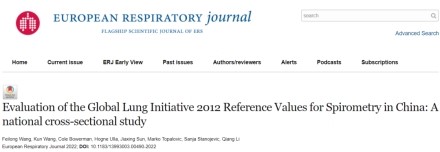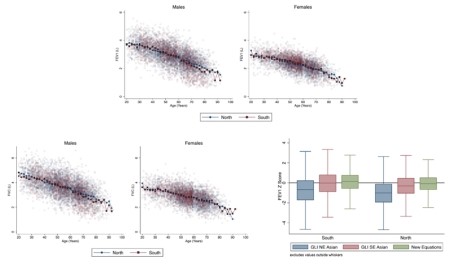Recently, LI Qiang, WANG Feilong and other people from the Respiratory Department of the Oriental Hospital affiliated to Tongji University published a research paper online entitled "Evaluation of the Global Lung Initiative 2012 Reference Values for Spirometry in China: A national cross-sectional study" in the European Respiratory Journal. This study is expected to establish a lung-function prediction equations suitable for Chinese people.

The paper published in European Respiratory Journal
China is faced with a heavy burden of respiratory diseases. According to the previous research by Academician WANG Chen among others, nearly 100 million people in China suffer from chronic obstructive pulmonary disease, and more than 45 million people asthma. Pulmonary function test, a main way to diagnose and evaluate the curative effect of these respiratory diseases, is also an important means to evaluate the development of teenagers. It has been used by hundreds of millions of people in China.
However, China has not yet established a lung function equation based on the characteristics of its own population. In 2012, the European Respiratory Association (ERS) launched the lung function prediction equations (GLI-2012 equations) for populations in different countries, which was later supported by all major respiratory associations and organizations around the world. The equations were promoted and applied in many countries. According this research, the pulmonary function index (corrected age and height) of the population in northern China, including FEV1 (forced expiratory volume in the first second) and FVC (forced vital capacity), was significantly higher than that of the population in the south (Qinling Mountains and Huaihe River boundary is used for the distinction between the north and south). Therefore, different lung function prediction equations were recommended for the population in the north and south of China, that is, the people in the south used GLI-2012 Southeast Asia equations (GLI-2012 SE Asia equations), and the Northerners used the GLI-2012 Northeast Asia equations (GLI-2012 NE Asia equations). However, this research only included the lung function data of a small sample size of Chinese people, and its applicability in Chinese people lacks the support of high-quality research.
At present, it is estimated that the normal lung function of the Chinese population mostly adopts a variety of corrected lung function equations of the Western population, including the 2012 European Respiratory Association study. The lung function prediction equations used by different regions and hospitals are not consistent. It is unclear whether these corrected pulmonary function equations can accurately reflect the real pulmonary function index of the Chinese population, and inappropriate application of these equations may seriously affect the diagnosis and treatment of respiratory diseases and the assessment of the severity of the disease in China. Therefore, the establishment of lung function prediction equations suitable for Chinese population is of important clinical significance.
In this cross-sectional nationwide study led by LI Qiang and WANG Feilong, the researchers collected the lung function data of 11392 healthy people over 20 years of age without smoking history from 28 provinces, cities and autonomous regions in China. These lung function testing processes were conducted strictly in accordance with the standards of ATS/ERS in 2005, and high-quality data were further obtained through artificial intelligence screening. After analysis, the researchers found that, on the whole, there was no significant difference between the lung function index of the people in the north and south of China with FEV1: 95% CI: -0.05-0.01, FVC: 95% CI: -0.01-0.05, and p greater than 0.05, which showed that the suggestion of the lung function prediction equations of the Chinese people recommended by the European Respiratory Disease Association was not accurate. In the elderly population, the pulmonary function index of the northern population is slightly higher than that of the southern population, and the analysis shows that there may be potential cohort factors.

The study showed that the lung function prediction equations recommended by the European Respiratory Association for Chinese people was not accurate
Further analysis showed that the use of GLI-2012 NE equations significantly overestimated the lung function index of people in the north and south of China, while GLI-2012 SE equations were relatively suitable for the entire Chinese population. On the basis of this large sample data, the researchers used the Lambda-Mu-Sigma method to establish a new lung function prediction equation, and found that the new equation can better fit the data of the Chinese population, showing a smaller standard deviation of index z.
In conclusion, the study found out that the recommendations on Chinese population in the lung function prediction equation for population in different countries launched by the European Respiratory Disease Association in 2012 were not completely accurate and needed to be further revised. On this basis, the study established a new prediction equation of lung function suitable for Chinese people, which is expected to provide new evidence for the diagnosis and treatment of respiratory diseases in China.
Professor LI Qiang, director of the Respiratory Medical Center, is the corresponding author of the paper, and Professor WANG Feilong is the first author. WANG Kun, a postdoctoral fellow in the Respiratory Department, and SUN Jiaxing, a doctoral student, participated in the research work. The research was supported by the national key research and development program of the Ministry of Science and Technology.
Paper link:https://erj.ersjournals.com/content/early/2022/07/07/13993003.00490-2022
